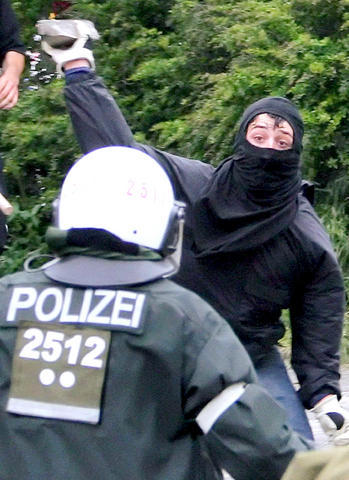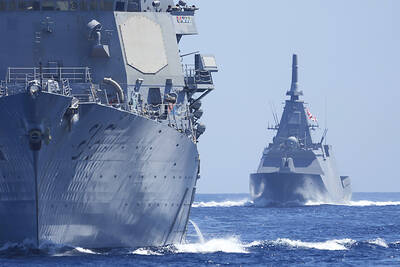Protesters with black hoods and bandanas covering their faces showered police with rocks and beer bottles before the heavily armored officers drove them back with water cannon and tear gas during a rally against an upcoming G8 summit.
Black smoke from burning cars mingled with the sting of tear gas in the harbor-front area of the northern German town of Rostock on Saturday, where tens of thousands of people had gathered peacefully at the start of the day. The clashes broke out among hundreds of stone-throwing demonstrators and police on the edges of the crowd as the rally progressed.
Some 146 police were hurt, 25 of them seriously. Police said they made 17 arrests.

PHOTO: EPA
It was an unruly start to what is expected to be a week of rallies against the three-day G8 summit beginning on Wednesday in the fenced-off coastal resort of Heiligendamm, 22km from Rostock.
German Chancellor Angela Merkel will host the leaders of Britain, France, Japan, Italy, Russia, Canada and the US for discussions on global warming, aid to Africa and the global economy. The summit, like past ones, is attracting protesters opposed to capitalism, globalization, the war in Iraq and the G8 itself.
Police have surrounded the summit site with a fence topped with barbed wire and closed the surrounding waters and airspace, fearing terrorism or disorderly protests like the ones that marred a 2001 summit in Genoa, Italy, where police and protesters clashed for days and one demonstrator was killed. Protests near the fence have been banned.
In Rostock, the officially permitted demonstration began peacefully on Saturday with two groups of marchers gathering at the waterfront. Clashes broke out near the end of the scheduled four-hour rally, as some people pried up paving stones and broke them into smaller pieces.
Eventually, five large green police trucks with twin water cannons mounted on top moved in to blast the rioters. A police car was destroyed and several parked cars burned, spreading black smoke over the area.
Police spokesman Frank Scheulen estimated the number of violence-minded demonstrators at about 2,000. Police put the size of the demonstration at 25,000, while organizers said it was 80,000.
Werner Raetz, anti-globalization activist with Attac, one of the organizing groups, distanced himself from the violence.
"There is no justification for these attacks," he said.
As for the demonstrations planned over the next few days, Raetz said both sides should try to get the "emotional situation" under control.
There are several camps in the area for protesters, and marches and other events are planned. Some protesters say they intend to try to block roads leading to the summit site.
Peter Mueller, who was among the demonstrators, had tears streaming from bloodshot eyes after the tear gas was released.
"As long as the police were in the background it was OK, but as soon as one took a step closer, it went out of control," he said. "What can you do? So ends the peaceful protest."
The protest was organized by several dozen groups under the motto "another world is possible."
Also see story:
Bush catches Europe off guard

A fire caused by a burst gas pipe yesterday spread to several homes and sent a fireball soaring into the sky outside Malaysia’s largest city, injuring more than 100 people. The towering inferno near a gas station in Putra Heights outside Kuala Lumpur was visible for kilometers and lasted for several hours. It happened during a public holiday as Muslims, who are the majority in Malaysia, celebrate the second day of Eid al-Fitr. National oil company Petronas said the fire started at one of its gas pipelines at 8:10am and the affected pipeline was later isolated. Disaster management officials said shutting the

US Vice President J.D. Vance on Friday accused Denmark of not having done enough to protect Greenland, when he visited the strategically placed and resource-rich Danish territory coveted by US President Donald Trump. Vance made his comment during a trip to the Pituffik Space Base in northwestern Greenland, a visit viewed by Copenhagen and Nuuk as a provocation. “Our message to Denmark is very simple: You have not done a good job by the people of Greenland,” Vance told a news conference. “You have under-invested in the people of Greenland, and you have under-invested in the security architecture of this

UNREST: The authorities in Turkey arrested 13 Turkish journalists in five days, deported a BBC correspondent and on Thursday arrested a reporter from Sweden Waving flags and chanting slogans, many hundreds of thousands of anti-government demonstrators on Saturday rallied in Istanbul, Turkey, in defence of democracy after the arrest of Istanbul Mayor Ekrem Imamoglu which sparked Turkey’s worst street unrest in more than a decade. Under a cloudless blue sky, vast crowds gathered in Maltepe on the Asian side of Turkey’s biggest city on the eve of the Eid al-Fitr celebration which started yesterday, marking the end of Ramadan. Ozgur Ozel, chairman of the main opposition Republican People’s Party (CHP), which organized the rally, said there were 2.2 million people in the crowd, but

JOINT EFFORTS: The three countries have been strengthening an alliance and pressing efforts to bolster deterrence against Beijing’s assertiveness in the South China Sea The US, Japan and the Philippines on Friday staged joint naval drills to boost crisis readiness off a disputed South China Sea shoal as a Chinese military ship kept watch from a distance. The Chinese frigate attempted to get closer to the waters, where the warships and aircraft from the three allied countries were undertaking maneuvers off the Scarborough Shoal — also known as Huangyan Island (黃岩島) and claimed by Taiwan and China — in an unsettling moment but it was warned by a Philippine frigate by radio and kept away. “There was a time when they attempted to maneuver